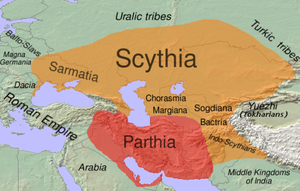斯基泰人
| 斯基台人 | |
|---|---|
 斯基泰人公元前1世纪的分布范围 | |
| 總人口 | |
不详 | |
| 分佈地區 | |
中亚 今巴基斯坦 今印度北部 今中华人民共和国西北部 | |
| 相關民族 | |
印度-伊朗人 |
系列条目 | ||||||||||||||||||||||||||
| 哈萨克斯坦历史 | ||||||||||||||||||||||||||
|---|---|---|---|---|---|---|---|---|---|---|---|---|---|---|---|---|---|---|---|---|---|---|---|---|---|---|
 | ||||||||||||||||||||||||||
游牧时期 | ||||||||||||||||||||||||||
| ||||||||||||||||||||||||||
后游牧时代 | ||||||||||||||||||||||||||
| ||||||||||||||||||||||||||
主题 | ||||||||||||||||||||||||||
| ||||||||||||||||||||||||||

斯基泰武士

斯基泰金饰
斯基台人(古希臘語:Σκύθης或Σκύθοι; 英语:Scythian)也譯为斯基泰人、斯基提亞人 、西古提人[1]、叔提雅人[2]、西徐亞人或塞西亞人,希臘古典時代在歐洲東北部、東歐大草原至中亞一帶居住與活動的农耕民族,一部分为半游牧民族,他們的領土被稱為斯基提亞;古代波斯人稱之為塞克人(古波斯语:Sakā,也译为薩迦人),分為戴尖帽塞克人、飲豪麻汁塞克人、海邊塞克人[3]。中國《史記》、《漢書》記錄的塞種可能源自這個民族[4],是哈萨克草原上印欧语系东伊朗语族之游牧民族,其隨居地從今日俄羅斯平原一直到河套地区和鄂爾多斯沙漠,与中国甲骨文和文献的鬼方、犬戎是史载最早游牧民族之一。
目录
1 概述
2 争议
3 参见
4 附註或參考
5 參考文獻
6 延伸閱讀
7 外部链接
概述
斯基泰人善于耕种和商贸,但也养马,据近代西方学者研究骑术与奶酪等皆出於其发明;公元前7世纪曾对高加索、小亚细亚、亚美尼亚、米底以及亚述帝国大举入侵,威胁西亚近七十年,其骑兵馳騁於卡帕多细亚到米底、高加索到叙利亚之间,寻找掠夺物;其後逐渐衰落,分为众多部落,公元373年随被稱為「上帝之鞭」的匈人阿提拉王率領,入侵欧洲,一度抵達巴黎近郊之阿兰人(注意不是阿瓦尔人),即为其中之一部。有人認為,现在定居在阿富汗西南部的普什图族Sakzai部落,就是斯基泰人的后裔;现在定居在俄罗斯的北奥塞梯-阿兰共和国、格鲁吉亚和已事實獨立的俄羅斯的衛星國南奧塞梯共和國的奧塞梯人,也是斯基泰人的后裔。
斯基泰人没有文字,但善於冶金打造飾物,留下了許多金器至今。
争议
- 斯基泰人之说,源自希腊历史学者希罗多德的《历史》(HISTORIAE)一书。该书成书于公元前五世纪,确切时间并不明确。而没有其它更加有力的证据证明,斯基泰人源自欧洲的说法。因此,不仅斯基泰人的族属存疑,就是其语言印欧语系的说法,也因为该语系已经受到学者们的质疑,而产生疑问。
- 即使在希腊和其他地区的古文献上都没找到相当证据情况下,一些不相干的民族也时常被近代西方历史学家和民族学家归为斯基台人或被认为与其相关,如萨尔马提亚人,但他们之间不一定使用同一个族名,一些普遍被近代西方学者当为斯基台人或与其有关的民族部落包括萨尔马提亚人、塞迦、奄蔡和阿史那氏等等。
- 斯基台人到底是农耕民族多于游牧民族还是后者多于前者,当中的农耕民族和游牧民族是否属于同一个族群的问题上仍有争议,《隋书·鐵勒传》将远至黑海北岸的部落都统称为“鐵勒”,并指出“近西邊者,頗爲藝植,多牛羊而少馬”,即越靠西边的这些蛮族部落越从事农业,多养牛羊,而少养马,和中原地区差不多,属于非游牧民族。
- 斯基台人是否有像匈奴人一样建立过部落体制国家,其部落体制国家的范围和地域有多辽阔及发展过程,是否也像匈奴人一样有一套完整的官僚体制,在其部落体制国家下是否如匈奴人一样被自己统称为一个族名或如黑鞑靼、白鞑靼、胡人等称谓一样仅仅为文明程度高低或地域上所划分的称谓的问题上仍有争议。
参见
- 塞迦
- 斯基提亞
附註或參考
^ 聖經和合本歌羅西書3:11
^ 《思高聖經》〈哥羅森書〉3:11:「在這一點上,已沒有希臘人或猶太人,受割損的或未受割損的,野蠻人、叔提雅人、奴隸、自由人的分別,而只有是一切並在一切內的基督。」
^ 聯合國教科文組織 (UNESCO) 著,徐文堪、芮傳明譯:《中亞文明史》,第二卷 (北京:中國對外出版翻譯公司,2001),頁8-12、20-23。
^ 周雲. 百家廊:尖帽塞人西域影響大. 3月2日 [2008-03-08]. 请检查|date=中的日期值 (帮助) 引文格式1维护:日期与年 (link)
參考文獻
.mw-parser-output .refbegin{font-size:90%;margin-bottom:0.5em}.mw-parser-output .refbegin-hanging-indents>ul{list-style-type:none;margin-left:0}.mw-parser-output .refbegin-hanging-indents>ul>li,.mw-parser-output .refbegin-hanging-indents>dl>dd{margin-left:0;padding-left:3.2em;text-indent:-3.2em;list-style:none}.mw-parser-output .refbegin-100{font-size:100%}
Anthony, David W. The Horse, the Wheel, and Language: How Bronze-Age Riders from the Eurasian Steppes Shaped the Modern World. Princeton University Press. 2010-07-26 [2015-01-18]. ISBN 1400831105.
Baumer, Christoph. The History of Central Asia: The Age of the Steppe Warriors. I.B.Tauris. 2012-12-12 [2015-01-18]. ISBN 1780760604.
Beckwith, Christopher I. Empires of the Silk Road: A History of Central Eurasia from the Bronze Age to the Present. Princeton University Press. 2009-03-16 [2014-12-30]. ISBN 1400829941.
Boardman, John; Edwards, I. E. S. The Cambridge Ancient History. Volume 3. Part 2. Cambridge University Press. 1991 [2015-03-02]. ISBN 0521227178.
Bonfante, Larissa. The Scythians: Between Mobility, Tomb Architecture, and Early Urban Structures. The Barbarians of Ancient Europe: Realities and Interactions. Cambridge University Press. 2011. ISBN 978-0-521-19404-4.
Davis-Kimball, Jeannine. The Scythians in southeastern Europe. Nomads of the Eurasian Steppes in the early Iron Age (PDF). Zinat press. 1995. ISBN 1-885979-00-2.
Day, John V. Indo-European origins: the anthropological evidence. Institute for the Study of Man. 2001 [2015-03-02]. ISBN 0941694755.
Drews, Robert. Early Riders: The Beginnings of Mounted Warfare in Asia and Europe. Routledge. 2004. ISBN 978-0-203-07107-6.
Sinor, Denis. The Cambridge History of Early Inner Asia. Cambridge. 1990. ISBN 978-0-521-24304-9.
Sulimirski, T. Chapter 4: The Scyths. (编) Gershevitch, Ilya. The Cambridge History of Iran 2. Azargoshnasp.net. 1985: 149–99.
Szemerényi, Oswald. Four old Iranian ethnic names: Scythian – Skudra – Sogdian – Saka (PDF). Veröffentlichungen der iranischen Kommission Band 9. Wien: Verlag der Österreichischen Akademie der Wissenschaften; azargoshnap.net. 1980.
Waldman, Carl; Mason, Catherine. Encyclopedia of European Peoples. Infobase Publishing. 2006 [2015-01-16]. ISBN 1438129181.
West, Barbara A. Encyclopedia of the Peoples of Asia and Oceania. Infobase Publishing. 2009-01-01 [2015-01-18]. ISBN 1438119135.
延伸閱讀
- Alekseev, A. Yu. et al., "Chronology of Eurasian Scythian Antiquities Born by New Archaeological and 14C Data". Radiocarbon, Vol .43, No 2B, 2001, p 1085–1107.
- Davis-Kimball, Jeannine. 2002. Warrior Women: An Archaeologist's Search for History's Hidden Heroines. Warner Books, New York. 1st Trade printing, 2003. ISBN 0-446-67983-6 (pbk).
- Gamkrelidze and Ivanov (1984). Indo-European and the Indo-Europeans: A Reconstruction and Historical Typological Analysis of a Proto-Language and Proto-Culture (Parts I and II). Tbilisi State University.
- Harmatta, J., "Studies in the History and Language of the Sarmatians", Acta Universitatis de Attila József Nominatae. Acta antique et archaeologica Tomus XIII. Szeged 1970, Kroraina.com
(德文) Jaedtke, Wolfgang. Steppenkind, Piper Verlag, Munich 2008. ISBN 978-3-492-25146-4. This novel contains detailed descriptions of the life of nomadic Scythians around 700 BC.- Johnson, James William, "The Scythian: His Rise and Fall", Journal of the History of Ideas, Vol. 20, No. 2 (Apr., 1959), pp. 250–257, University of Pennsylvania Press, JSTOR
- Lebedynsky, I. (2001). "Les Scythes: la civilisation nomade des steppes VIIe–IIIe siècle av. J.-C." / Errance, Paris.
- Lebedynsky Iaroslav (2006) "Les Saces", Editions Errance, ISBN 2-87772-337-2
- Mallory, J.P. (1989). In Search of the Indo-Europeans: Language Archeology and Myth. Thames and Hudson. Chapter 2; and pages 51–53 for a quick reference.
- Newark, T. (1985). The Barbarians: Warriors and wars of the Dark Ages. Blandford: New York. See pages 65, 85, 87, 119–139.
- Renfrew, C. (1988). Archeology and Language: The Puzzle of Indo-European origins. Cambridge University Press.
- Rolle, Renate, The world of the Scythians, London and New York (1989).
(俄文) Rybakov, Boris. Paganism of Ancient Rus. Nauka, Moscow, 1987- Torday, Laszlo (1998). Mounted Archers: The Beginnings of Central Asian History. Durham Academic Press. ISBN 1-900838-03-6.
外部链接
维基共享资源中相关的多媒体资源:斯基泰人 |
- 斯基泰人
- 黄金之主——西伯利亚的斯基泰人
Scythians overview by Chris Bennet
Livius website articles on ancient history, entry on Scythians/Sacae by Jona Lendering- The early burial in Tuva
- Color illustrations of Scythian gold
- Published excavations of royal Scythian kurgan (barrow) at Chertomlyk reviewed
- all known Scythian kings listed on Regnal Chronologies
Herodotus, Histories, Book IV – translated by Rawlinson, 1942 edition
Livio Stecchini, "The Mapping of the Earth: Scythia": reconstructing the map of Scythia according to the conceptual geography of Herodotus
- Livio Stecchini, "The Mapping of the Earth: Gerrhos"
1998 NOVA documentary: "Ice Mummies: Siberian Ice Maiden" Transcript- on Sarmatian (a related Iranian group) trade and ethnic connections
"A chronology of the Scythian antiquities of Eurasia based on new archaeological and C-14 data", Alekseev, A.Y. et al. A detailed scholarly article on pre-Scythian, early Scythian and classical Scythian archaeological sites and their dating, by the Hermitage Museum's director of archaeology and others.
"Some problems in the study of the chronology of the ancient nomadic cultures in Eurasia (9th–3rd centuries BC)", Alekseev, A.Y. et al. More of the same.
"Scythian Gold From Siberia Said to Predate the Greeks" A journalist's article on the Arzhan finds, quoting Hermitage experts- Geldings for the Gods
An Introductory Bibliography on Scythia (法文)
- Меновые отношения скифоидного населения Подонцовья
- Ryzhanovka
Archaeology abstract of 1997 article- the Ryzhanovka Kurgan in Ukraine
- Ryzhanovka
- Genetics
Haplogroups in India (PDF file)- Y-Chromosome Biallelic Haplogroups
- Unravelling migrations in the steppe: mitochondrial DNA sequences from ancient central Asians.
- Ancient DNA provides new insights into the history of south Siberian Kurgan people
| ||||||||||||||||||||||||||||||||||||||||
| ||||||
|

Comments
Post a Comment